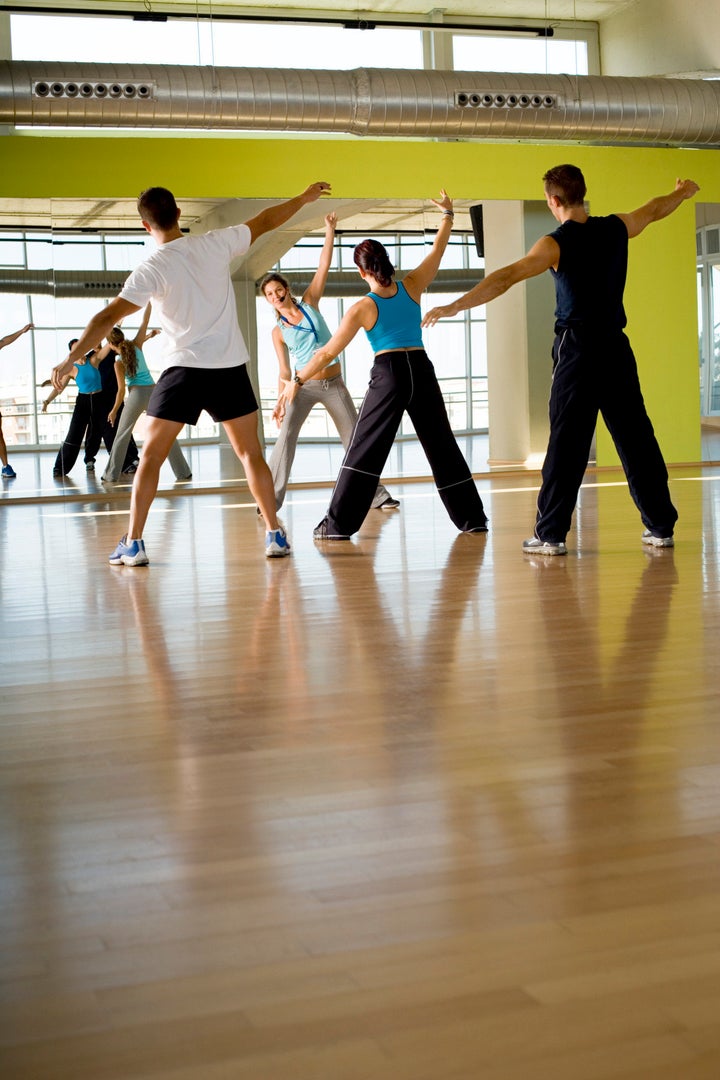
Quick -- where can you go to sway like a belly dancer, build strength like a weightlifter and sprint like a sergeant? If you belong to a typical modern fitness center, you already know the answer. Group fitness classes have entered a new era, and their offerings surpass simple aerobics by leaps and bounds.
"One of the biggest changes in group fitness is the variety of classes that are offered," says Melissa Baumgartner, certified fitness instructor and spokeswoman for the American Council on Exercise. Those classes are designed to cover a range fitness interests and levels, and some are even devoted solely to specific muscle groups.
A study of fitness trends by the American College of Sports Medicine found that workout junkies are becoming more focused on traditional strength and core training, while former staples -- most notably Pilates -- are losing popularity.
But not to worry if you're seeing fewer of your go-to classes on the schedules these days -- plenty of newer ones will do the job. "The changes in classes give people lots of variety so they don't get burned out," said Marjorie Albohm, president of the National Athletic Trainers' Association. And if you're new to the group fitness world, take heart -- these days, there's something there for everyone.
Dance Classes
If the thought of lifting weights or pounding out the miles on a treadmill is keeping you away from the gym, you might be a candidate for some of the dance aerobics classes that are filling up fitness club calendars. From African dance to burlesque, the variety of offerings seems endless.
And they're worth your time, experts say. "The intensity level of these classes is doable, and it's a good workout," Baumgartner said, adding that dance-based classes force you to move your body in ways you probably wouldn't in a more traditional workout.
Among the most common styles in recent years has been Zumba, a Latin-inspired dance class that takes elements of traditional dances, such as salsa and merengue, and blends them into routines with a fast-paced beat. The idea is to get your heart rate up and to move to the music instead of focusing on repetitious movements.
In the same vein is Batuka, a mix of aerobics and dance moves set to a similar Latin beat. According to the Batuka website, the word "Batuka" is based on the Batucada -- a festive Brazilian style of music. Batuka instructors are trained to teach choreographed routines that involve a full-body workout.
Belly-dancing classes, meanwhile bring a Middle Eastern flair to the group fitness world and can make you forget you're at the gym. Belly dancing classes are available in a surprising number of variations, some of which include props and strong dance beats. They're appropriate for people of all fitness levels and provide a full-blown abdominal workout in addition to cardiovascular exercise.
Strength-Training Classes
Many of today's strength-training classes get their tricks "straight from the military world," Baumgartner said. These classes often incorporate some cardio with a full-body strength workout. Strength-training classes have an advantage over weight room workouts because many people miss major muscle groups if left to their own devices, Albohm said.
One type of strength-training class is total body conditioning. These classes can be a mixed bag in terms of specific exercises, but they almost always live up to their name. Instructors often combine weight training -- think body bars, free weights and many lunges and squats -- with a bit of mild cardio. Expect tough strength training that will give you stronger, more toned muscles.
If you want a solid mix of cardio and strength training, boot camp is the answer. Boot camps are a form of circuit training that comes straight out of the military handbook. Instructors create stations for a workout that alternates rigorous cardiovascular exercise -- such as sprints and jumping rope -- with traditional workout moves such as pushups and situps. Boot camp is never for the faint of heart, but many of the moves can be adapted to different fitness levels -- just ask the instructor for tips.
Oldies But Goodies
Some types of classes seem to have a permanent following and haven't faded from gym schedules. Most of them have evolved with time -- yoga classes set to music, for example, or spinning classes that incorporate ab workouts.
Perhaps no form of self-improvement has developed as many variations as yoga. It's virtually impossible not to find a version that suits your fancy: There's hot yoga and dance yoga and a yoga class for just about every time of day and every state of mind. Start with a class that's specifically intended for beginners, Brehm suggested. Once you get a feel for the terminology, poses and philosophical approach, you'll have a better idea of what to try next.
Sometimes, though, the introspective nature of yoga just doesn't fit your mental state. Or perhaps it's not a match for your personality at all. If you're one of those people who thinks there's no better way to end a stressful workday than by throwing a few punches, give kickboxing a try. Most gyms have at least one kickboxing class that combines cardio with intense calisthenics.
For the ultimate indoor cardiovascular conditioning class, check out spinning. In this stationary-bike workout, instructors lead you through a course that often includes intense sprints and laborious hills. If treadmills do too much damage to your joints or your psyche, this is the class to try.
By: Leigh Remizowski
"The New World Of Group Fitness" courtesy of LIVESTRONG.COM.